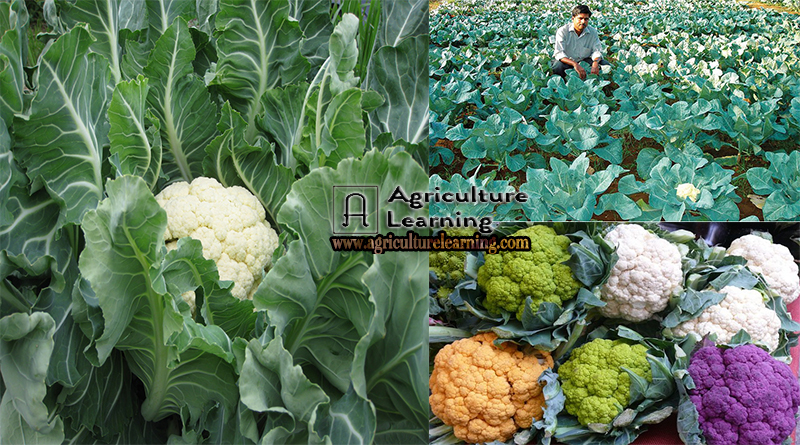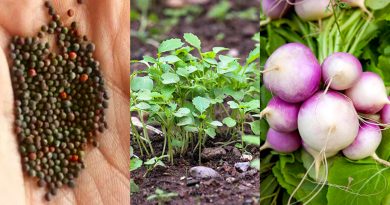Cauliflower modern cultivation Process and its health benefits
Cauliflower (Brassica oleracea var. botrytis L.) is one of the most daily consumed important vegetables of commercial crops in the world. Mainly, cauliflower is grown with seeds and belongs to the family of “Brassicaceae”. The white part of flower is used for culinary purpose. The stalk and surrounding thick, green leaves are used in vegetable broth or can be fed as fodder for livestock. It is one of the popular winter vegetables of Bangladesh. It can be grown in greenhouse or polyhouse. Cauliflower is rich in minerals like potassium, sodium, calcium, iron, phosphorus and magnesium. It also contains vitamin A and C.
Local Names of cauliflower in other parts of the world: – Blumenkohl (German), Bloemkool (Dutch), Korifurawa (Japanese), Coliflor (Catalan), Coilis (Irish), Kauli (Nepali), conopida (Romanian), Chou Fleur (Franch), Covolfiore (Italian), Kubis Bunga (Malay), Gol Kalam (Persian), cvetaca (Slovenian).
Varieties: In Bangladesh, the cauliflower varieties are categorized in three groups considering planting time:
Early planting – Patnai, Kartika, Agrahyani, Pusa dipali, Early snowball, Tropical 55 days, Tropical 45 days.
Medium planting – Poushali, Snowball X, Snowball Y, Snowball 16, Agrahyani, BARI, Fulcopi-1 (Rupa), BARI, Fulcopi-2.
Late planting – Unique snowball, Maghi Banarashi Poushali Main crop, Rakhushi late.
Climate, land and soil: The varieties of cauliflower are very much sensitive to temperature and photoperiodic requirements. It is, therefore, essential to select the proper variety to be sown at the proper time. Cauliflower generally requires a cool and moist growing season. It cannot withstand too low or too high temperature. High temperatures produce poor quality curds like leafy, fuzzy, looze and yellow colored ones. It may be grown on a wide range of well-drained soil. However, the early varieties prefer sandy loam, whereas for the late varieties, loam or clay loam is preferred. The optimum PH for this crop is 5.5 to 6.6.
Seed rate: About 250-300g seeds are required for one hectare of land. Twenty nursery beds (1 m x 3 m) are required to grow the seedlings for one hectare of land.
Seed treatment: To get healthy seedling, the seeds should be treated before sowing with Provax @ 2.5 g/kg of seed. Then the seeds should be sown densely in a primary seedbed.
Time of sowing: For early planting, sowing of seeds should be done by 15th August, for medium planting by 15th September and for late planting by 15th of October.
Seedbed preparation: The primary seedbed should be well pulverized and mixed with 3-4 kg well-rotted cow dung/bed (3m2). Make narrow lines of 1-1.5 cm deep and 4 cm apart and sow the seeds continuously in lines and cover with fine soil and water lightly. Seeds are made to germinate within 3-4 days. Protect the seedbed from direct sun and rain. The nursery beds should be prepared in the same way as primary beds with an addition of 30g urea, 15g MP and 15g TSP/bed. Nursery bed should be prepared 3-5 days before transplanting of seedlings from primary bed. After one week of emergence, uproot the seedlings and transplant immediately in the nursery beds at a spacing of 4 cm x 4 cm, provide light irrigation and protect the seedlings from direct sun and rain. Weeding and irrigation should be given when necessary.
Land preparation: Land should be deeply ploughed, well pulverized and weed free. After final preparation of the land, prepare 1 m wide and 15-20 cm high bed will be done. In between two beds 30 cm wide canals which will help in irrigating the crop as well as in drainage.
Transplanting method: Transplanting age of the seedlings is 30-35 days having 5-6 true leaves. Irrigate the seedbed lightly to minimize root damage before uprooting the seedling from seedbed. On the bed, two rows 60 cm apart should be made and transplant the seedlings on the rows at a spacing of 45 cm to 60 cm (depending on the variety). Transplanting in the late afternoon is suggested to allow the seedlings to recover during night. Immediate post-transplanting irrigation is the best method of crop establishment. Missing hills should be filled up with spare good seedlings within 10 days after planting.
Fertilizer dose and application method: The cauliflower requires heavy manuring as it removes large quantities of major nutrients from the soil. The recommended doses for cauliflower are cow dung: 5-10 tons/ha; urea: 250-300; TSP: 150-200; MP: 200-250; Borax: 10-15 kg/ha and Sodium molybdate: 2 kg/ha, respectively.
The entire amount of compost, TSP, Borax, Sodium molybdate and half of the MP should be applied during final land preparation. The entire urea and rest of the MP are to be applied in three equal installments. It is recommended that one additional dose of urea and MP (100 kg each per hectare) is to be applied during flowering for seed production.
Irrigation: Irrigation is given according to the crop requirements and climatic condition. A crop after transplanting may need irrigation twice a week and later once a week. Adequate moisture supply during flowering and seed development are necessary to obtain high seed yield.
Intercultural Operation: Shallow hoeing should be done in order to remove the weeds and loose the soil for better aeration to facilitate better root growth.
Pest Management
Major insects and its control measures:
Diamond back moth
Control measures:
- Removal and destruction of all the remnants, stubbles debris etc. after the harvest of crop and plough the fields.
- Application of IPM approach in field (Picking of the egg masses and larvae of diamond back moth and prodenia caterpillar).
- Sequential release of Trichogramma @ 1g (25,000) and Bracon hebetor @ 1bunker (800-1200).
- Spray Cypermethrin @ 1.5 ml/l of water or Spinosad @ 0.5 ml/l of water at 15 days interval.
Butterfly
Control measures:
- Hand picking and mechanical destruction of caterpillars at early stage of attack would reduce population of pest.
- In case of severe infestation spraying with Quinalphos (Kinalux, Debiquine 25EC @ 1.5 ml/l of water).
Common cutworm/ Prodenia caterpillar
Control measures:
- Practice IPM (Picking of the egg mass and Prodenia caterpillar) two times during total cropping period.
- Use of sex pheromone trap.
- Spray Cypermethrin @ 1.5 ml/lof water or Spinosad (Tracer 45 SC @ 0.5 ml/l of water at 15 days interval.
Aphids
Control measures:
- Hand picking at initial stage.
- Conservation of natural enemies like lady bird beetle and syrphid fly.
- Spray soap water @ 5 g/l of water 2-3 times at 7-10 days interval.
- Apply Neem oil + trix 2-3 times @ 5 ml/l of water at 7-10 days interval.
Major diseases and its control measures:
Alternaria leaf spot
Control measures:
- Seed treatment with Provax 200 @ 3g/kg of seed.
- Foliar spraying with Rovral (2 ml/1 litre of water).
Cercospora Leaf spot
Control measures:
- Seed treatment with Provax/Vitavex 200 @ 3 g/kg of seed.
- Foliar spray of Autostin or Knowin @ 2 kg/litre of water.
Harvesting and Seed preservation: Cauliflower should be harvested when the curd has attained the proper size, bright color and compactness. The plant is cut off well below the curd so that the stub thus left protects the curd during transport and marketing. Solid and compact curds of white color are required for quality cauliflower. The yield may range from 15 to 25 ton/ha depending on variety and maturity group. Like cabbage, the early group varieties give lower yield than the mid-and late-group varieties.
Seed harvest and preservation: Harvesting can be done when pods are brown. Too ripe pods dehisce. Seed should not crash or split when rubbed between the hands. The harvesting may be done in two lots. Generally, the early plants are harvested first, when the pod color of about 60 to 70 percent of the pods turn brown and the rest of the crop changes to a yellowish brown. After harvesting it is piled up for curing. After 4 to 5 days it is turned upside down and allowed to cure for another four to five days in the same way. It is then threshed with sticks and sifted with hand sifters. After thorough drying of seed in partial sun light (up to 7 percent moisture content) than it should be cleaned and stored in cool room or air tight container.
Health benefits of Cauliflower:
- Cauliflower good for pregnant women.
- It is rich in calcium and minerals.
- It boosts vitamin ‘K’ and calcium content.
- It is good for skin health.
- It lowers blood cholesterol levels.
- It detoxifies the body system.
- It promotes heart health.
- Regular Consumption of cauliflower reduces certain types of cancer risks.
- It aids in weight loss management.
- It builds healthy immune system.
Source: BARC





Everything is very open with a precise clarification of the challenges. It was really informative. Your website is useful. Thanks for sharing!
dolores quasi quibusdam recusandae modi qui aut similique recusandae est deserunt sit et repellendus aut in. quis modi doloribus labore odio nam explicabo aliquam. asperiores illo et temporibus illo eum. eum ea sed amet fugit dolor et et natus molestias.